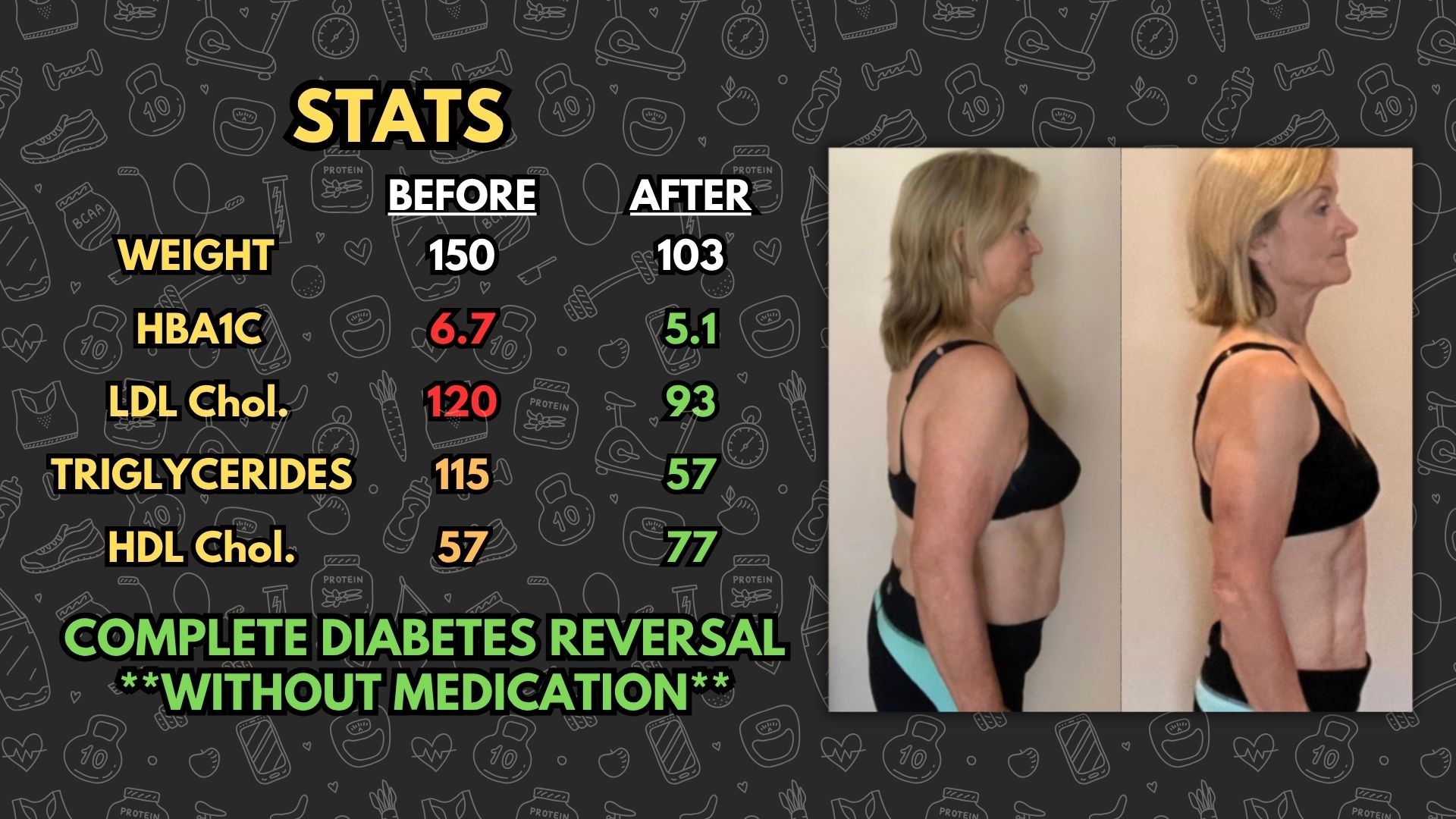Categories
practical health journalThe Practical Health Journal - September 30th, 2025
Read this on Healthyandwholeyou.com
Read Time: 7.6 Minutes
The 4 Step Protocol We Use
For Diabetes Recovery
Hey Friend,
As you may already know, Healthy & Whole as a health coaching and sustainable weight loss program has been able to achieve results far and above the rest of the industry for some time now.
What you may not know because we don’t talk a whole lot about it, is that we have had repeated success time and time again helping many clients fully recover their A1c and blood sugar regulation while losing weight.
We have done it so many times at this point that we have dialed in a fully repeatable process and protocol that allows us to see A1c and blood sugar numbers move from full Type 2 Diabetes or Pre-Diabetes range all the way down into normal range and to then be maintained within normal range.
In today’s newsletter I am going to outline each of the steps in this 4 step protocol in detail, because whether these steps are done with us or not, they are still the same steps that virtually anyone must follow to recover fully from or fully control diabetes.
So without further ado, let’s dive in to The 4 Step Healthy & Whole A1c Recovery Protocol
Step 1: Understand The Real Problem / Cause
You can’t fix a problem you don’t understand.
I’m no mechanic, so if you ask me to fix the engine in your car (or my own) we are both going to be completely out of luck.
This is the sad reality that most who have a pre-diabetes or type 2 diabetes diagnosis are faced with.
They have a problem that needs desperate fixing, and yet they have no understanding of the problem or the root causes themselves. Their engine is broken, and they don’t know why or how to fix it.
So the very first thing we do with our clients is to educate about why the problem is happening in the first place, so that they can fully understand exactly how to fix the problem, which in this case is uncontrolled blood sugars.
We start by educating our clients around what we call The Bucket Analogy, which is an analogy that helps you to understand how your body regulates blood sugar and how that is impacted by the food you eat and your daily activity.
You can watch a training here on this concept, but in a nutshell the issue with type 2 diabetes is that a person is consuming more carbohydrate on a daily / weekly basis than their body can use or store effectively, and all that excess has nowhere to go in the body, hence high blood sugar levels and lots of stress on the liver as the liver works overtime to convert excess blood sugar to fat to clean it out of the blood.
We educate first, so that our clients know what must be done to solve the problem…then we start coaching on exactly how to do that.
Step 2: Fix Carbohydrate Intake
We then start with a lot of education and implementation to clean up and optimize daily food intake to solve the over consumption of carbohydrate that is causing the “overflow” of blood sugars.
For most of our clients this means we start completely from scratch with a full re-education in the realm of nutrition with 2 goals:
- The client needs to know how to identify and quantify carbohydrates in the food they eat on a daily basis. If they can’t read labels, identify foods with carbohydrate in them, portion those foods properly, and balance them into a day of eating…then they cannot have any control over their blood sugar or diabetes.
- Once the client has a base education, the second goal is to educate them on what a day of balanced eating looks like so that they can eat the RIGHT amount of carbohydrate on a daily basis that will allow for healthy blood sugar regulation again. ESSENTIALLY, eating within their body’s capacity for processing, using, or storing carbohydrate on a daily basis again.
What is the "right" amount of carbohydrate on a daily basis for most people?
That's a great question.
While many gurus will give either give a very precise number or simply say "It's going to be different for everyone" we have actually found that it's a pretty consistent range for most people.
At Healthy & Whole we have found great success keeping daily carbohydrate intake around 75 to 100 grams of carbohydrate a day on average, with an upper limit for most people around 150 grams if they are hitting a daily step goal and strength training consistently.
Armed with education in this area and coached through successful implementation of day to day eating, we can typically have the carbohydrate intake issue fixed in the first week of working together, which allows us to move onto step 3…
Step 3: Optimize Daily Activity + Exercise
Part of the problem with pre-diabetes and type 2 diabetes is not just excessive carbohydrate intake, but also often a real lack of daily activity and exercise.
One of the first things we teach our clients is that activity and exercise acts very much like insulin in the body. When you walk immediately after a meal, you see blood sugars naturally come back down faster than if you don’t.
Higher intensity activities like strength training or interval training cardio sessions preferentially use carbohydrate / sugar for fuel, so by doing those we increase our body’s use of carbohydrate, and in the process we increase our body’s daily capacity for carbohydrate.
So by fixing the overconsumption of carbohydrate, and then increasing daily walking and adding in strength training, we attack diabetes and insulin resistance from both sides and this is how we are able to achieve normalization of blood sugar regulation with our clients in a relatively short amount of time…usually 3-6 months.
What are the ideal daily / weekly exercise and activity goals for the average person?
We like to strive for an average of 8,000 steps a day and 3 strength training workouts as week as a sustainable baseline that yields great results in terms of weight loss and overall health as well supporting longevity and healthy blood sugar regulation.

It is perfectly fine to walk more than 8,000 steps a day or to workout more than 3 times a week, but we like to speak in terms of minimum standards so that our health is built on sustainable foundations first, and then anything above and beyond those sustainable minimum standards is just icing on the cake. 🎂
Once we have fixed the internal blood sugar regulation issue with lifestyle change in the realm of nutrition and exercise…we move on to the final step in the process…although technically…we are working on step number 4 the entire time from day 1.
Step 4: Make It Sustainable
The final step in our protocol is to ensure that the lifestyle changes our clients are making are also made sustainable in the process.
This means a few things:
- The food they are eating must be highly enjoyable. They must have a lot of variety in their food so they can’t get burnt out. They must be fully capable and skilled to eat well at home, and outside of the home in restaurants, including how to have cheat meals and how to recover fully. And they must have ultra convenient options for the busiest times of life that still meet their needs nutritionally.
- They need to have fully built daily walking / activity and weekly strength training 2-3 times a week into their lifestyle as routines that have a permanent place in their daily / weekly routines.
- They must know how to flex and flow with the ebbs and flows of life particularly in regard to winter months, prolonged vacations, navigating holiday seasons, and how to adjust if they are injured and cannot be as active as they used to be for a time.
All of these are real life situations that require real life education and skills to navigate. Without these skills, sustainability is impossible.
So we always make sure to build these things in along the way with our clients, and by doing so this is how we not only get the kind of weight loss results we get, but we are also able to get significant improvements in A1c / blood sugar markers, and to do it sustainably so they will remain stable for the foreseeable future.
I'm launching some thing new tomorrow...
I can't share the details here just yet, but tomorrow on my Facebook profile I'll be opening the doors to something specifically targeted at helping those with diabetes or pre-diabetes to lose weight and to accomplish significant improvement if not a full recovery with their blood sugar regulation and blood markers.
It's all built upon this same 4 step protocol I've outlined above, and it's responsible for the results we've experienced with clients like Pam here who experienced a sustained full recovery from diabetes and got into amazing shape at the same time.

If you don't already follow me on Facebook you can do that here, and keep an eye out for details on this new opportunity coming tomorrow evening (October 1st).
Conclusion
Controlling and even reversing diabetes is a very real possibility for most who have pre-diabetes or type 2 diabetes, but it is a process and it does take time, energy, and focus.
Obviously, it is not possible for me to teach in detail every part of that process in a newsletter, but my hope with newsletters such as this one is that I can at least open the eyes of those with pre-diabetes or type 2 diabetes to the right path and the right things to focus on.
Until next time,
— Coach Matt
When you're ready, here's how I can help:
If you're looking to lose weight sustainably while building a flexible lifestyle that you enjoy, I can help. Apply for coaching here in the Healthy & Whole Mentorship Program.
Disclaimer: This email is provided for educational and informational purposes only and does not constitute providing medical advice or professional services. The information provided should not be used for diagnosing or treating a health problem or disease, and those seeking personal medical advice should consult with a licensed physician.




